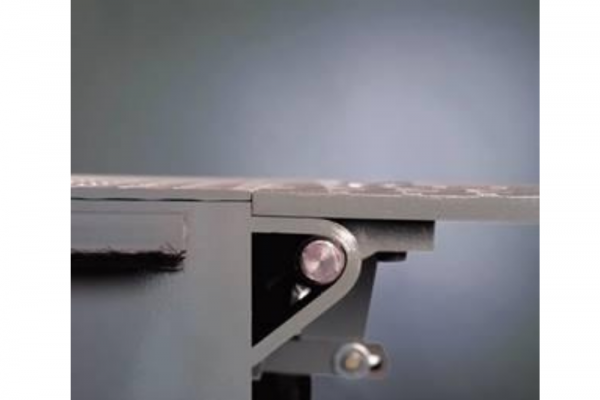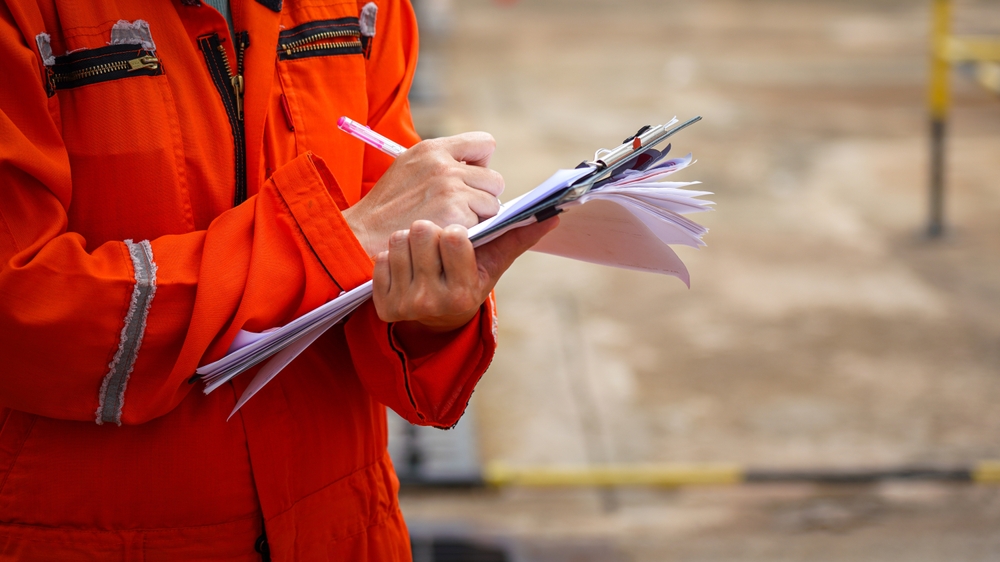WHY QUALITY DOCK LEVELER FRONT HINGES MATTER
Dock levelers bridge the gap and help correct the height difference between the dock and the trailer. They also compensate for the up and down float of the trailer bed during loading.
For a facility that operates 3 shifts per day, 5 days per week, and averages 1 hour to unload/load a trailer, a dock leveler is being operated (placed and stored) roughly 2000 times per year (not counting adjustments) and is driven across 100 thousand times per year. At this level of activity, special attention must be paid to the part of the dock leveler that is one of the highest moving components and withstands a considerable amount of the cargo’s weight; the front lip hinge.
Where Is The Dock Leveler Front Hinge Located?
The front leveler hinge (or lip hinge) is located between the leveler deck and the lip of the leveler. It is active every time the leveler’s lip is raised, lowered, or adjusted. In this location, it is frequently crossed and bears the full weight of the material handling equipment and load.
What A Dock Leveler Front Hinge Does
The leveler hinge lip is used to raise the lip from its resting, pendant position and lower it into the trailer, allowing it to rest firmly on the trailer floor and close the gap between the warehouse floor and trailer bed. As previously mentioned, the front dock leveler hinge is active every time the leveler’s lip is raised, lowered, or adjusted:
- Raised: The lip is kicked up (Either mechanically or hydraulically) to prepare for placement in the trailer bed.
- Lowered: The leveler and lip are placed in the bed of the trailer bed for material transfer
- Adjustments: If the leveler is not placed correctly in the trailer bed, the lip will need to be raised again for corrections to the lip placement.
The Importance of Dock Leveler Hinge Strength
Due to the frequency of use the front dock leveler hinge endures, its strength is imperative. Two factors that help strengthen and prolong leveler lip life; are a proper crown and hinge support.
The Crown is an adjustment to the lip hinge to help account for the difference in height between the loading dock and trailer bed. The crown of a leveler will be standard, reduced, or increased:
- Standard: Lip crown will be level if typical trailers are coming in at relatively the same height as the loading dock leveler
- Reduced: Lip crown should be reduced if typical trailers are coming in at and/or below loading dock level
- Increased: Lip crown should be increased, if typical trailers are coming in significantly higher than the loading dock level
With traditional levelers, there may be a need to build in an extra crown, beyond the facility’s needs of height difference between the loading dock and trailer. This approach accounts for wear and tear the leveler experiences during operation, especially when the hinge is not being supported or reinforced. While this may temporarily help prolong the life of the lip hinge, it also forms a “speed bump” that in turn can cause Whole Body Vibration (Dock Shock) felt by the forklift driver.
Hinge Support is a feature of dock levelers that can assist the front hinge by taking on more of the weight (forklift and cargo) and also determines the type of crown the leveler has (based on leveler design). With this reinforcement, there is less need for an increased crown, which consequently helps remove the impact felt by the driver, equipment, and products.
Front Dock Leveler Hinge Impact
When a lip hinge has proper support and crown, this provides a seamless or smooth transition from the deck of the leveler, across the lip, and into the trailer bed. If any component is off, this can lead to product and/or equipment damage, more importantly, potential injury to the forklift driver.
- Driver: Forklift operators crossover dock levelers over 100,000 times per year. Hitting a potential “speed bump” at the lip hinge transfers Whole Body Vibrations to the driver, which can result in acute or chronic injury; especially when turned to exit the trailer. Back-related injuries are more common, most seen in the first year on the job.
- Equipment: Much like the Dock Shock felt by the driver, this jarring impact can cause damage to the material handling equipment over time (more commonly tires or steering components of a forklift).
- Products: A smooth transition is equally important when it comes to products. Jostling of goods on a pallet, especially more fragile cargo, can result in damage and potential fines to a warehouse to compensate for materials that arrive in poor condition.
Stokes Equipment’s Solution
Approximately 20 percent of acute low back pain sufferers develop chronic lower back pain within one year, which can be attributed to Whole Body Vibration (Dock Shock). Help reduce personnel injuries by choosing a leveler with a full Smooth Transition Dok System™.
Stokes Equipment dock levelers utilize an exclusive Two-Point Crown Control design which supports the dock leveler front hinge through two points of contact (back edge of the lip and underside of the lip), while its uniquely shaped front header helps to control the crown; providing only what the facility needs. This helps to extend the life of the lip hinge while reducing the “speed bumps” felt during the loading process.
Stokes Equipment’s leveler’s structural design, inclusive of the industry’s only Smooth Transition Dok System, provides an even area for forklifts between the warehouse floor and the trailer beds. Each Smooth Transition features Constant-Radius Rear Hinge, Two-Point Crown Control, Optimized Lip Chamfer, and a Self-Flexing Leveler Deck. Contact us to learn more about our dock leveler parts in South Jersey!





